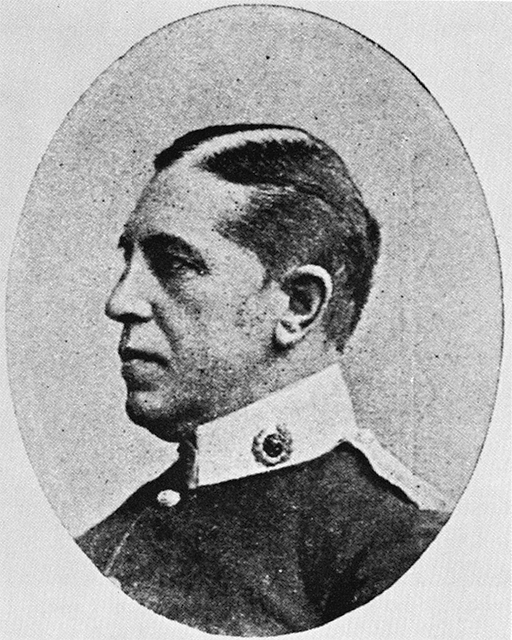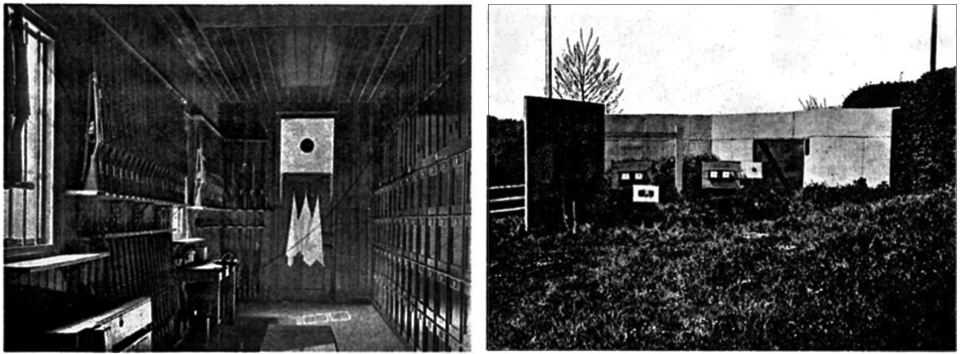The History of the Volunteer Company at Winchester Diocesan Training College
The Volunteer Force, later the Territorial Force, had an important part to play in the lives of many of our 61 students who died in the Great War. Several of the students, commemorated in the Chapel at the University of Winchester, settled in the local area when their training was complete and continued their association with the unit or the Hampshire Regiment of which it was part. The camaraderie forged in uniform was a strong bond and part of their lives for the two years that they were in College. They had friends and acquaintances in the Hampshire Territorial Force. Those in the College Territorial Company in the summer of 1914 were on exercises with the Regiment when war was declared.
The rise of the Volunteer Force, which later became Territorial Companies, started in 1859. There was a circular letter, dated 12th May from the War Office to the Lords Lieutenant of the English Counties which resulted in the raising, over the following two years, of various Rifle Corps. One of these was the 1st Hants Rifle Corps, based in Winchester.

On the 24th February 1875 it was decided to form a College Company. This was authorized by the War Office and given the title The Winchester Diocesan Training College Corps, or the 24th Rifle Corps. The Volunteer Company at Winchester was part of the 1st Volunteer Battalion Hampshire Regiment.
The original uniform was a light grey with green facings and black braiding. By the time the College Force was formed they were armed with the Snider rifle, the first breech loading rifle of the British Army. Drill was carried out on the Ditch (or Dytche), a College field, while shooting practice took place at Teg Down. There were various locations used for annual camps. The College Principal was commissioned into the Company. In 1877 the uniform changed to scarlet with black facings, eventually changing to fit in with the regular battalions of the Hampshire Regiment. A shooting club was formed in 1880, and in the same year the Volunteer Force became known as ‘I’ Company of 1st Hampshire Rifle Volunteer Corps. Membership of I Company was mandatory for students and they enrolled in their first weeks of their first term. The College Company therefore included the entire student body along with several staff members and former students.

In 1881 the College Company attended camp and paraded at the Great Volunteer Review in Windsor Park. Each year they attended a camp which included exercises, manoeuvres, parades, drills and competitions. These camps were held at various venues around the south of England including Salisbury Plain and Hayling Island.
In 1885 the Volunteer Force, now known as the 1st Volunteer Battalion Hampshire Regiment, replaced the Snider rifle with the Martini-Henry rifle, which in turn was replaced by the Lee-Metford magazine rifle in 1897. Also in that year a new armoury was erected at the Training College. It was fitted out with racks for rifles and lockers for uniforms and equipment and was located south of the student common room. The following year the annual camp was held in the New Forest. The Cyclists Section represented the battalion in the military skills competition that was held every year.
The importance of the Volunteer Force in College life is illustrated by how quickly their military training began after entering College. The students started at the College half way through September. As soon as possible after that they were putting in two drills a day from 2pm-3pm and 3pm-6pm until they had completed at least 30 drills and were deemed to be efficient, the aim being to achieve this by the end of October. This of course was on top of a full academic timetable. The Volunteer Force was inspected as part of College Inspections. In 1893 the Adjutant told the Inspector that the College Company was the best within the Volunteer Corps and that they had the best marksmen.
In December 1905 Richard Haldane, Secretary of State for War introduced the concept of having an army which could be mobilised in time of need without needing to introduce conscription. He described this as a ‘real national army, formed by the people’. He proposed the formation of a Territorial Force, centrally resourced and directed but run by local territorial associations. The initial implementation was to take the existing old Volunteer and Militia units and convert them into Territorial Companies. This was legislated in the Territorial and Reserve Forces Act 1907 and known as part of the Haldane Reforms of the Army.
In 1908 the Volunteer Force ceased to exist and in its place the Territorial Force was formed. The College Company became ‘B’ Company of the 4th Territorial Battalion of the Hampshire Regiment. This was more than just a change of name. Students previously had automatically been enrolled in the Volunteer Force. In the Territorial Force they were enlisted after signing an Attestation form—effectively a contract not only to train in time of peace but to fight in time of war. This was a significant change and with it came different conditions of service. The students were subject to a more professional system, which included military discipline and more thorough training. These changes meant that membership was no longer insisted on by the college authorities; students were given a choice and although the vast majority of students did enlist a few did not.

When war was declared in August 1914, ‘B’ Company was at its annual camp at Bulford on Salisbury Plain. The Company was made up of 104 men, 40 of them being students in their final year. As members of the Territorial Force they were immediately mobilised and remained with the Company on Salisbury Plain. They were joined by the Principal and one of the College tutors. They were moved from the Bulford Camp to Hilsea, Portsmouth, where they were stationed from August 4th to 10th before returning to Salisbury Plain. There they trained at Bulford Camp, Sling Plantation, Hamilton and Bustard Camps. They then had what must have been a very strange experience: the unit was moved back to the students’ familiar College surroundings, which were pressed into use as billets, on October 5th until December when they were sent to India. Winchester Training College was used by the War Office for the duration of the war.
V S Manley, a Wintonian, wrote in his diary a list of the Wintonians who volunteered for service in Mesopotamia and what happened to them. This was a contemporary account and is not necessarily complete or wholly accurate (emphasis and links added to men on the College Memorial).
- 3381 Purkis H S, Pte, Jersey. Died of disease (whilst a prisoner of war at Kut-al-Amara)1
- 1865 Smith Ralph, L Cpl, Swindon. Shot in elbow 21/1/19162
- 3084 Singleton C F, Pte, Codford, Wilts. Died3
- 2167 Bolwell F J W, Pte, Radstock. Killed
- 1869 Windust A H, Pte, Eastleigh, Hants. Survived
- 2185 Oakley C R, Pte, Broseley, Salop. Shot through shoulder 21/1/1916
- 1862 Rose H W, Pte, Ongar, Essex. Killed in action4
- 3078 Hurst G T , L Cpl, London. Wounded 21/1/1916
- 3611 Richardson J J, Pte, I.O.W.
- 3616 Soper W T, Pte, Cowes, I.O.W.
- 2195 Tarrant A, Pte, Wroughton, Swindon. Killed in action
- Clifford W O, Pte, Charlton
- 1867 Warne A, Pte, Brightstone, I.O.W. Killed in action
- 2199 Woodfield A, Pte. Died of disease 8/6/1916
- Rodd G W Shanklin, I.O.W.
- Butcher J, Pte, Canterbury
- (Westminster Training College 3081 Pittuck B, Pte, London)

Researcher and Author: Dee Sayers with additional notes by John Vickers
Sources
Rose, M. (1981). A history of King Alfred’s College, Winchester 1840-1980. London: Phillimore.
Manley, V.S. (1916-1919). A Khaki Diary, (Volumes 1-6, Vol. 4 missing), Hampshire Record Office Archive, 47M91W/Q3/6/1, 47M91W/Q3/6/2, 47M91W/Q3/6/3, 47M91W/Q3/6/5, 47M91W/Q3/6/6, Winchester.
Thomas, Capt. R.A., ed., The History of The Volunteer Company at the Training College, Winchester. Hampshire Record Office Archive, 47M91W/R2/5, Winchester.
- Purkis was not amongst the soldiers besieged at Kut. He did die as a prisoner of the Turks. Henry was taken to Baghdad and died at Shuman while being transported as part of a prisoner exchange.
- Smith, Oakley and Hurst were all injured at the Battle of Umm-el-Hannah.
- Singleton and Bolwell died of disease as prisoners of the Turks after being besieged at Kut-al-Amara.
- Rose, Tarrant and Warne were all killed in action at the Battle of Umm-el-Hannah
